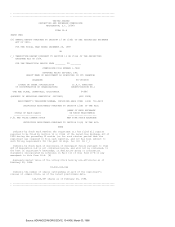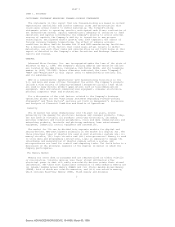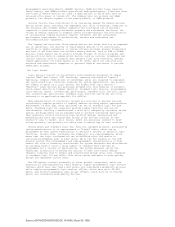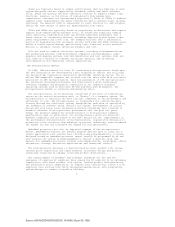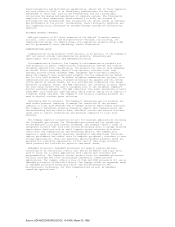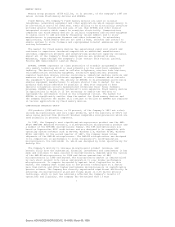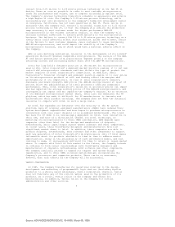AMD 1997 Annual Report Download - page 13
Download and view the complete annual report
Please find page 13 of the 1997 AMD annual report below. You can navigate through the pages in the report by either clicking on the pages listed below, or by using the keyword search tool below to find specific information within the annual report.products and in the fabrication of Flash memory devices. If the Company is not
successful in its microprocessor and Flash memory businesses, it will be
unable to recover such investments, which could have a material adverse effect
on the Company. In addition, any inability of the Company to remain
competitive with respect to process technology could have a material adverse
effect on the Company.
COMPETITION
The IC industry is intensely competitive and, historically, has experienced
rapid technological advances in product and system technologies. After a
product is introduced, prices normally decrease over time as production
efficiency and competition increase, and as a successive generation of
products is developed and introduced for sale. Technological advances in the
industry result in frequent product introductions, regular price reductions,
short product life cycles and increased product capabilities that may result
in significant performance improvements. Competition in the sale of ICs is
based on performance, product quality and reliability, price, adherence to
industry standards, software and hardware compatibility, marketing and
distribution capability, brand recognition, financial strength and ability to
deliver in large volumes on a timely basis.
In each particular market in which it participates, the Company faces
competition from different groups of companies. With respect to the
Communications Group product lines, the Company's principal competitors are
SGS Thomson, Texas Instruments, Siemens, NEC, LM Ericsson, Alcatel, National
Semiconductor, 3Com, Intel and Motorola. With respect to the Memory Group, the
Company's principal competitors are Intel, Sharp and Atmel. The Company
competes to a lesser degree with Fujitsu Limited, its joint venture partner in
FASL. With respect to microprocessors, Intel holds a dominant market position.
In Vantis' market, the Company's principal competitors are Altera, Lattice
Semiconductor, Xilinx and other smaller companies focused on programmable
logic device development and production.
MANUFACTURING FACILITIES
The Company's current integrated circuit manufacturing facilities are
described in the chart set forth below:
PRODUCTION APPROX.
WAFER SIZE TECHNOLOGY CLEAN ROOM
FACILITY LOCATION (DIAMETER IN INCHES) (IN MICRONS) (SQUARE FOOTAGE)
----------------- -------------------- ------------ ----------------
Austin, TX
Fab 25................. 8 0.25 & 0.35 89,700
Fab 15................. 6 0.7 22,000
Fab 14................. 6 0.8 22,000
Fab 10/1/.............. 5 0.9 22,000
Aizu-Wakamatsu, Japan
FASL/2/................ 8 0.35 & 0.5 70,000
FASL II................ 8 0.35 91,000
Sunnyvale, CA
SDC.................... 6 & 8 0.25 42,500
- --------
(1)Fab 10 will decrease production levels and close by the end of 1998.
(2)The Company owns 49.992 percent of FASL. Fujitsu owns 50.008 percent of
FASL.
In the third quarter of 1997, FASL completed construction of the building
for a second manufacturing facility in Aizu-Wakamatsu, Japan (FASL II) at a
site contiguous to the existing FASL facility. In addition, the Company
commenced construction in the second quarter of 1997 of a manufacturing
facility in Dresden, Germany (Dresden Fab 30), through a wholly owned
subsidiary of the Company. AMD also has foundry arrangements for the
production of its products by third parties.
10
Source: ADVANCED MICRO DEVIC, 10-K405, March 03, 1998



